By Karla Davis
Observant eyes roamed around a space filled with the buzzing sounds of the 1970s. Paint and African history creeped into the cavities of my nose. The newly installed Circa 1970 exhibition greeted me as I opened the doors of the Studio Museum.
The Studio Museum recently added a new set of art pieces to their collections. The themes of these pieces range from the current “Black Lives Matter” movement, to 1970s sociopolitical and cultural landscapes. In this article I will briefly touch upon a few of these works.
The very first new exhibit that I experienced was Circa 1970. Circa 1970 displayed a unified group of paintings, drawings, prints, photographs and sculpture. Featured works, such as that of artist Beauford Delaney, were created between 1970-1979. This collection makes known key moments in black culture and history, such as how the art world began to really open up its doors to black artists during this decade. In addition, dozen of artists, including Romare Bearden, Blackburn, Binion, Frank Stewart and many more, contributed to the making of this collection.
Subsequently, I proceeded to the second floor, where I found VideoStudio: Meeting Points. This collection showcased a set of videos by Theo Eshetu, Ezra Wube and Zineb Sedira, all of which delve into the genesis of identity through cultural exchange. Each work portrayed this exchange through three particular eras of European and African interaction: slavery, colonialism, and contemporary immigration. In these videos, marketplaces and ports from Germany all the way to Ethiopia serve as places for the negotiation of value and identity.
My next stop was Black Cowboy. This collection aimed to break the stereotype of the “typical white cowboy”. In this exhibition, you will find cowboys in unforeseen settings; for instance, at an outside basketball court. The photographs depicted in this exhibition substantiate the idea that African-American children and women too can assume the role of this figure. Black Cowboy broadens our idea of what makes an American icon and legacy.
My last stop was Richard Hunt: Framed and Extended. This exhibition was taken from a Chicago-based sculptor whom name is Richard Hunt. He is best known for his many public artworks, installed in an array of parks, schools, and public areas across the U.S. One of those sculpture sites is located in the intersection of 125th Street and Morningside Avenue in New York (titled: Harlem Hybrid). The Richard Hunt: Framed and Extended collection looks deeper into Hunt’s printmaking, small-scale sculpture and wall sculpture art. The exhibition’s title derives from one of Hunt’s wall sculptures,which attest to his practice of using sculptures as the three-dimensional opposite of traditional paper drawing.




